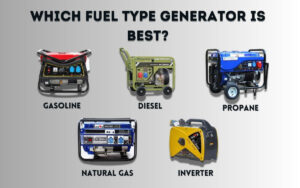Can you use a regular generator for welding?
Whether you’re repairing farm equipment, creating metal art, or working on a construction site, welding allows metal parts to be joined together in a strong and durable way. These days, many people are looking for cost-effective ways to power their welding equipment.
A common question is, can you weld with a regular generator? Since dedicated welding generators are often expensive, it’s easier to consider using a regular generator you already have. The answer not only affects your welding results, but also the safety of your operation and the life of your equipment.
In this article, MATCHUP will explore the technical requirements of a welding power source, what regular generators can actually handle, and help you understand the difference between a welding generator and a standard portable generator.

Welding power requirements
Welding requires a lot of electricity to generate the high heat needed to melt and join metals. Different welding processes have different power requirements, and understanding these requirements can help ensure a successful weld and select the right equipment.
Common welding processes and Their Power Requirements
- Stick metal arc welding (SMAW) – One of the most common welding methods, stick metal arc welding typically requires 30-200 amps, depending on the thickness of the metal.
- MIG Welding – Commonly used in the automotive and manufacturing industries, MIG welders typically require 30-250 amps. A steady power source is essential to maintain a smooth arc.
- TIG welding – This precise welding process requires 10-200 amps. TIG welding is highly sensitive to power fluctuations.
- Flux cored arc welding (FCAW) – Similar to MIG welding, but without the shielding gas, this method requires 30-250 amps.
Welders have specific power requirements – steady and plentiful power. So, can a regular generator meet that need?
Using a regular generator for welding
Using a regular generator for welding may seem economical, but there are still some challenges and risks to consider. Here are some key factors to consider before using a regular generator for welding, and we have also provided some tips to help you use regular generators for welding safely and effectively.
Power fluctuations and their effects on weld quality
The power supply from a portable generator can experience fluctuations, such as surges and spikes. Sudden fluctuations and dips in voltage can adversely affect the performance and functionality of the welder, increasing the risk of overloads and short circuits. In addition, these power fluctuations can lead to problems with smooth, precise welds, such as:
- Low strength or poor quality welds.
- Excessive spatter, making welds messy and requiring more frequent cleanup.
- Interruptions in welding, resulting in defects such as cracks or lack of fusion.
This is particularly noticeable when working with precision work, stainless steel, or using TIG and MIG welders.
A voltage regulator or automatic voltage stabilizer (AVR) can help smooth out power fluctuations, reducing the risk of arc instability, excessive spatter, or damage to the welder. This is especially important when working with precision welding tasks.
Alternatively, you can use manual welding (SMAW) as it is suitable for thicker materials that require less perfect arc stability.
Unclean power can damage welding equipment
Many standard generators produce dirty power, which means they have high total harmonic distortion (THD)—often over 6%. Welders, especially inverter welders, require clean power with a THD of less than 5% to work properly. Dirty power can cause:
- Overheating of the welder, shortening its life.
- Damage to electronic components, leading to expensive repairs or replacements.
- Erratic arc behavior, making welding more difficult to control.
Inverter generators, or generators designed specifically for welding, generally provide cleaner power, making them safer for welders. If possible, use an inverter generator instead of a conventional generator.
Choosing the right generator size is critical
Voltage (V) determines how easy the arc is to start, and is typically 120V or 240V, with 240V providing more power for heavier welding tasks.
Current (A) controls the heat output and penetration of the weld. Welding thicker metals requires higher currents.
A generator that is too small will not provide enough power, resulting in poor weld quality and can even damage the equipment. You can get better help by following the recommendations below, which many welders follow.
- A welder with a maximum output of 160 amps needs a generator with a maximum output of 7kva or more.
- A welder with a maximum output of 180-200 amps needs a generator with at least 8 kVA capacity.
- A welder with a maximum output of 250 amps needs a generator with at least 13 kVA capacity.
If you are still unsure about what size generator to choose, the safest thing to do is to buy the next size up. The reason is simple: you need to choose a generator that can provide enough power for the welder while providing extra capacity to handle the starting surge and maintain stability.
Understand duty cycle
The duty cycle refers to the percentage of time in a 10-minute period that the welder can run before it needs to cool down. For example, a 60% duty cycle at 150A means that the welder can run for 6 minutes and then need to rest for 4 minutes. The generator must provide stable power throughout the entire duty cycle, otherwise overheating and equipment failure may occur. Check the generator specifications and reduce welding current or suspend operation as necessary to avoid overheating.
How to use a generator for welding?
We have covered all the basics, now it is time to learn how to use a generator for welding properly.
#1 First check the fuel tank of the generator to make sure there is enough fuel to start and complete the welding work smoothly. There should be no power outage during the process, otherwise it will directly affect your workflow.
#2 After checking the fuel tank, you can start the generator. It will help to unplug the power plug of the welder before starting the generator.
#3 After the generator starts, plug the power plug of the welder into the generator. If the socket is not suitable or incompatible, you can cut the welder plug and connect the cable to the new plug. After plugging in the power supply, you can start welding. (If you have a welder generator, it will come with a welding kit. You can skip this step and go directly to the next step.)
#4 The next step is to set the correct control settings of the welder. This is essential to get the correct voltage and current required for the welding project. Please adjust it according to the best effect to achieve the ideal welding effect.
#5 Finally, turn off all equipment after the work is completed. Doing so can help you save fuel, electricity, and energy. Additionally, it protects you from harmful flammable fuel emissions.
Welder + portable generator vs. Welding generator
Generators are generally divided into two types: standard generators and dedicated generators for welding. If you own a welding generator, you can rest assured that your welder will have the power it needs to complete the task. The latter can also be used just like a conventional generator for most tasks. Here are some significant advantages of welding generators:
- Protected against short circuits and generally have a longer service life
- Can work remotely, away from the main power source. This could be a city suburb, a remote farm, or a remote road.
- If the welding part is installed separately, a more compact design can be achieved.
- Costs less than a diesel generator of equivalent power.
- Can power other tools and equipment in an emergency.
Conclusion
While a regular generator can accomplish basic welding tasks in some cases, it is not the best choice for stable and reliable performance. For better results, investing in a welding generator is a smarter long-term solution. Welding generators provide stable, clean power to ensure smooth welding, protect your equipment and improve overall efficiency.
If you need a reliable welding power solution, explore MATCHUP high-quality generators designed for stable and efficient performance. In the long run, choosing the right equipment will save you time, money and trouble.

May Ge
Outdoor Machinery Export Manager 6-Yr Exp 🌍 ∣ BSCI, EPA, EURO V, CE ∣ Generator, High-pressure Washer, Water Pump, Engine, Floor Scrubber ∣ 🚀 24/7 Second Reply
TAIZHOU BISON MACHINERY CO.,LTD | Ningbo University of Technology
Our related blog

Which fuel type is best for generators?
This article is designed to guide you in choosing the right generator fuel type for your specific needs. By exploring the pros and cons of each fuel, we’ll help you make the best decision.

What are the main components of a generator?
MATCHUP will introduce the main components of a generator, how they work together, and their role in efficient power generation.

winterizing your portable generator
Below is a complete guide to winterizing your portable generator. It contains all the tips and tricks you need to know. Keep reading to learn more.

Generator air filter cleaning
MATCHUP will reveal a step-by-step guide to safely cleaning your generator air filter and taking precautions to protect it from dust and debris.





